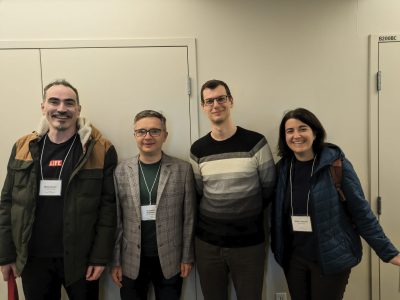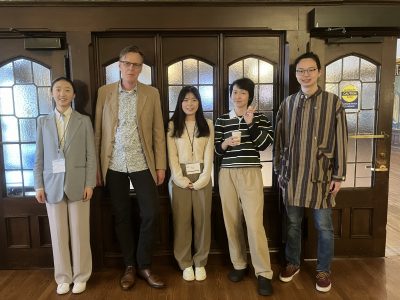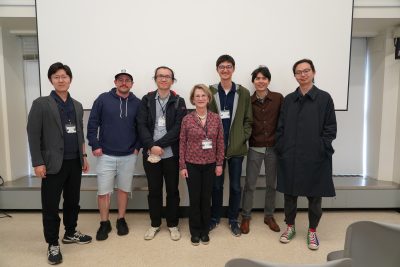Magdalena and Stefan Kaufmann gave a talk as part of the Theoretical Linguistics Colloquium at the University of Vienna on July 1st. Their talk was titled “Ways of being iffy”.
Author: Adrian Stegovec
Mizuno | Semantics & Pragmatics
The paper “Strategies for Anderson conditionals: Their implications for the typology of O-marking and X-marking” by recent alumni Teruyuki Mizuno (now at Ochanomizu University, Tokyo) has just been published as an early-access version in Semantics and Pragmatics. Congratulations Teru! The full paper can be accessed here.
Abstract: This paper contributes to the recent development of the research on O-/X-marking (von Fintel & Iatridou 2023) through providing novel data on so-called Anderson conditionals (Anderson 1951). While English has to use X-marking for Anderson conditionals, I show that Japanese Anderson conditionals cannot involve X-marking, thus suggesting a discrepancy across languages with respect to the way they express relevant constructions. I suggest that Japanese Anderson conditionals involve a perspectival shift analogous to the Historical Present, which I show to help bring the same semantic effects as X-marking would do. I discuss implications of my data for the uniformity hypothesis of X-marking submitted by von Fintel & Iatridou 2023. I also suggest that the availability of X-marking for Anderson conditionals and the availability of X-marking for Future Less Vivid conditionals (Iatridou 2000) seem to stand or fall together across languages.
UConn Linguistics at FASL
The 33rd annual meeting of Formal Approaches to Slavic Linguistics (FASL 33) was hosted by Dalhousie University (Halifax, Canada) on May 16th-19th. UConn linguistics was well represented with presentations by:
- Miloje Despić (PhD 2011, now at Cornell University). Negation and finiteness in BCMS
- Miloje Despić and Neda Todorović (PhD 2016, now at Reed College). On adjunction, complementation and the problem of present perfectives in BCMS
- Adrian Stegovec. Prosodic deficiency and person deficiency: What we can learn from cross-linguistic variation in Slavic clitic and weak pronouns (invited presentation, roundtable on “Trends and synergies in the research on Slavic clitics”)
- Krzysztof Migdalski (post-doc 2006-2008, now at University of Wrocław) and Hakyung Jung. Categorial mismatches of pronouns — a diachronic perspective
- Katarina Gomboc Čeh and Arthur Stepanov (PhD 2001, now at University of Nova Gorica). Processing syntactic dependencies in Slovenian heritage speakers
- Krzysztof Migdalski. UG determinism and phi-feature interpretability in the direction of language change (poster)
UConn linguists at FASL (left-to-right: Miloje, Krzysztof, Adrian, Neda):

UConn Linguistics at ICPC
The 45th International Child Phonology Conference (ICPC 2024) was virtually organized by the University of Louisiana at Lafayette on 7-9 May 2024. UConn linguistics was represented with a talk by:
- Shengyun Gu, Diane Lillo-Martin, Deborah Chen Pichler (PhD 2001, now at Gallaudet University), and Elaine Gale. ASL phonology develops early for deaf children in non-native signing home environment
UConn Linguists at ACAL
The 55th Annual Conference on African Linguistics (ACAL) took place on May 2-4, hosted by The Department of Linguistics at McGill University, and UConn linguistics was represented at the conference with talks by:
- Qiushi Chen. The cylic nature of grammatical tone in Chichewa
- Tarcisio Diss. An animacy restriction in Chichewa hyperraising
Photo of Tarcisio and Qiushi at the conference:

Incoming graduate class of 2024-25
Our department is pleased to announce the incoming graduate class for the 2024-25 academic year:
- Yao Lin
- Lydia Palaiologou
- Hiroaki Teraoka
- Heesun Yang
- Jiayi Zhou
Welcome! We’re looking forward to you joining us in the fall!
UConn Linguistics at CLS
The 60th annual meeting of the Chicago Linguistics Society (CLS) is taking place at the University of Chicago on April 26th-28th, and UConn linguistics will be well represented at the conference with talks by:
- Qiushi Chen. On the units of syntactic reanalysis: Evidence from two Sinitic languages.
- Stefan Kaufmann, Magdalena Kaufmann, & Stefan Hinterwimmer. In case falls is relevant.
- Alexandre Vaxman (PhD 2016, now at University of Tours). The morphemic weight scale in the lexical accent system of Nxaảmxcín (Moses-Columbia Salish).
- Zixi Liu. Contextuality in the height of A-positions: Nominative object construction in Japanese.
… and poster presentations by:
- Heesun Yang (incoming cohort 2024-25) and Bum-Sik Park (PhD 2005, now at Dongguk University). Korean High Negation Questions and Their Syntax and Semantics.
- Shangyan Pan. From ‘giving’ to receiving: the syntax and diachronic change of the Mandarin ‘give’.
The UConn Linguistics contingent at CLS 60:

Yoshiki Fujiwara | Job at Yamaguchi University
Yoshiki Fujiwara, who recently graduated from our program in 2022, has began his tenure-track job as lecturer at the Faculty of Humanities at Yamaguchi University. Congratulations Yoshiki!
UConn Linguists at WCCFL
The 42nd meeting of the West Coast Conference on Formal Linguistics (WCCFL 42), hosted by UC Berkeley, took place on April 12-14, 2024. UConn was well represented at the conference with talks by:
- Vicki Carstens. The (un)interpretability of grammatical gender: asymmetries of AGR with conjoined subjects as a formal diagnostic
- Yusuke Yagi. Some Reconstruction Effects are by Default Semantic
- Qiushi Chen. How to realize your lower copy: Evidence from Chichewa object dislocation
- Adina Camelia Bleotu, Andreea Nicolae, Anton Benz, Alexandre Cremers, Gabriela Bilbiie, Mara Panaitescu & Lyn Tieu (PhD 2013, now at University of Toronto). Does merely hearing and boost implicatures with disjunction or is relevance also needed?
… and posters by:
- Tarcisio Dias. Contextual markedness in Brazilian Portuguese size morphology
- Yoshiki Fujiwara (PhD 2022, now at Yamaguchi University). Across-the-board constructions in Japanese
- Yosuke Sato & Hiromune Oda (PhD 2021, now at University of Tokyo). Variation in Particle Stranding Ellipsis in the Two-Grammar Model for Japanese.
- Zheng Shen (PhD 2018, now at National University of Singapore) & Beth Chan. Wh-island effects and d-linking effects in wh-in situ questions.
- Pasha Koval (PhD 2023, now at NYU Abu Dhabi) & Jon Sprouse. Relative Clause Extraposition in English is created by rightward syntactic movement.
- Zixi Liu. How high can you get: Nominative object construction in Japanese
Pictured: Most of the UConn linguistics contingent at WCCFL

UConn linguistics at NACCL
The 36th North American Conference on Chinese Linguistics (NACCL-36) took place on March 22-24, hosted by Pomona College. UConn Linguistics was represented at the conference with talks by:
- Qiushi Chen. Be Careful Where You Reanalyze Your Syntax: On N(P)-fronting in Two Southwestern Mandarin Varieties
- Shangyan Pan. Gei as Functional Elements: How Many Are There?
- Jarry Chia-Wei Chuang & Danny Yi-Xiang Liao. Motivation of Checked Tone Merger in TSM: Syllable Structure and Tonal Pattern
- Jarry Chia-Wei Chuang & Lily Li-Ping Chen. Unifying OR-distinction & Moraic Model: The Status of Prenuclear Glide
- Pei-Jung Kuo (PhD 2009, now at National Chiayi University). A Zonal Inclusion Analysis for the Empathic Marker gei in the ba Construction